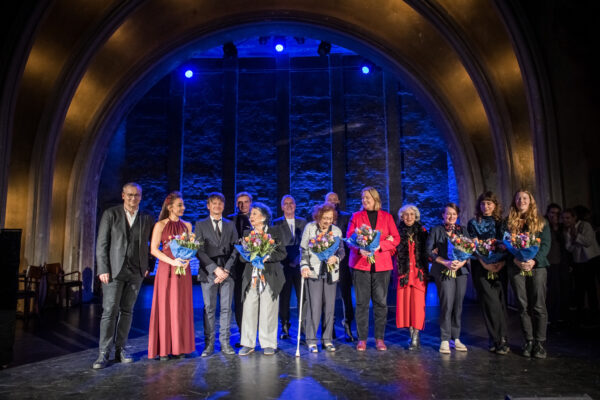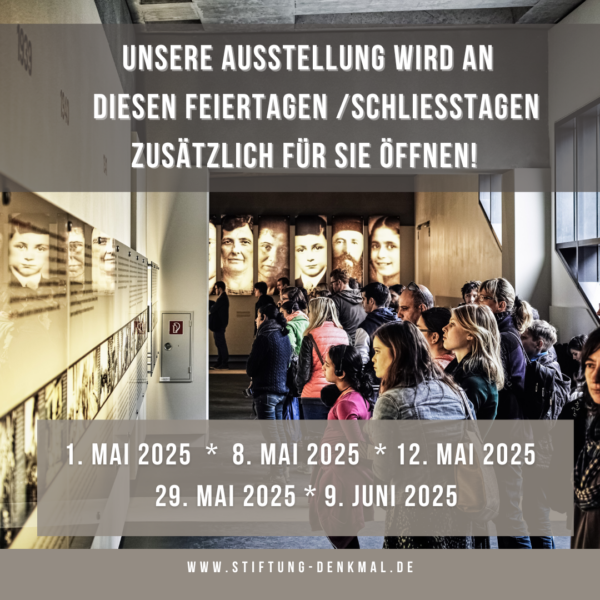The end of the Second World War marks the 75th anniversary of the end of the Second World War. Since 2005, the Federal Republic of Germany has commemorated the six million Jewish victims of the Holocaust with a monument to the murdered Jews of Europe. The foundation that oversees the monument began its work 20 years ago, on April 1, 2000. (See: stiftung-denkmal.de/stiftung/gruendung.)
Uwe Neumärker, director of the Memorial Foundation since 2009 for 75 years of the end of the war: “For the survivors, 8 May 1945 was the day of liberation, believing that their suffering had now come to an end. It was a day of hope to return home and meet relatives again. That hope was largely painfully disappointed. Often they could not return to their homeland or left and emigrated to build a new life far away from Europe. A life marked by silence about one’s own destiny. In addition, they had to fight for decades for their recognition as victims and a so-called reparation.”
Neumärker on 15 years of holocaust memorial: “The Holocaust Memorial was inaugurated 15 years ago, 60 years after the end of the war. It has taken Germany long, far too long to acknowledge its responsibility for the crimes committed. Three other monuments followed. These necessary symbolic places of remembrance must be signs against anti-Semitism, anti-Gypsyism, homophobia, against all forms of racism and exclusion of minorities in Germany and Europe, especially in the present and the future. We are not only guilty of this to the millions of murdered; it is the task that is and must be a daily obligation for us with a view to the past.”
Activities of the Memorial Foundation on the occasion of the 75th anniversary of the end of the war and 15 years of the monument
On 7 May 2020, 8 p.m., online commemoration (live on YouTube): Moderation: Claudia Roth, Interlocutors: Uwe Neumärker, Jörg Skriebeleit and actors read
biographies of Carol Schuler
On May 8, 2020 Samuel Koch reads names in the Holocaust Memorial (Live)
May 2020, 7 p.m., live interview with Regina Steinitz and Ruth Malin (live on YouTube), moderated by Maria Ossowski, an event of AMCHA Germany in cooperation with the Stiftung Denkmal. In October 2014, the foundation and Regina Steinitz presented their life memories in Berlin.
On May 10, 2020, exactly 15 years after the opening of the monument, the animated film »I believe in love …” on the life story of Sabina van der Linden-Wolanski can be seen on the Foundation’s website and its social media channels. Sabina said on May 10, 2005: “I am the voice of the six million…”
On 11 May 2020, a podcast series will start with Mirna Funk – Uwe Neumärker, Thilo Mischke – Lea Rosh, Sören Frey – Katharina Nesytowa, Alice Hasters – Friedmann Karig, Alina Stiegler – Leonard Kaminski. The series was created together with the support group. The interlocutors met for the first time and investigate the question: How do you remember today?
75years of the War.berlin
, partner of the Virtual Exhibition and augmented reality app of Berlin’s cultural projects on the occasion of the 75th anniversary of the end of the war (start: 2 May). All four memorial sites supervised by the Foundation are integrated and can be experienced on the basis of biographies. The website www.75-Jahre-Kriegsende.de is also included.
Questions to the director Uwe Neumärker
On 10 May 2005, the monument to the murdered Jews of Europe was officially opened. What has this monument achieved since then, and what has the Foundation achieved?
“The so-called Holocaust memorial has become a matter of course in the Berlin cityscape, according to a survey, after the Reichstag building and Brandenburg Gate, it is one of the most popular tourist attractions – not only in the German capital, but in the entire Federal Republic. After the bitter discussions about its construction, dedication and artistic design, the construction costs and the like, which are practically forgotten today, this is not a matter of course. These debates, however, were of immense importance for the Germans’ self-understanding of how to deal with the Nazi past after reunification, and also in the face of our neighbours’ fears of a new “Great Germany”. The monument is and remains a commitment to our historical responsibility for German crimes and murdered Jews from all over Europe. It is an expression of a social consensus, but in recent times some – a minority, which is unfortunately to be taken very seriously – have recently questioned. But the fact that it is the Holocaust memorial, which as a symbol of the reappraisal of National Socialism is unequivocally unequivocally denounced as a “monument of shame” and the reason for the demand for “a 180-degree change in memory politics”, only underlines its symbolic significance for this country all the more. However, we must not leave it at that: the monument also sets a sign of the present and the future, actively combating anti-Semitism, racism and all forms of exclusion and actively shaping our democracy.
After the ceremonial handover, we faced the challenge of organizing the operation of the place of information, developing educational programs and anchoring the foundation as an equal partner in the Berlin as well as the German, European and international memorial landscape. Nearly half a million visitors to the permanent exhibition each year, about 2,000 guided tours booked, as well as the recognition for our work and the visit of high-ranking state guests show that we were not completely wrong with our approach.”
How has the culture of remembrance developed in general over the past 15 years and how have the tasks and work of the Memorial Foundation changed accordingly?
“The decision of the German Bundestag to erect the monument to the murdered Jews of Europe in the summer of 1999 was coined with the self-commitment to “ensure the memory of all the victims of National Socialism and their appreciation in an appropriate manner”. According to the law, this is the task of the foundation. The decision to dedicate the national memorial not to all the victims, but exclusively to the European Jews, led – as expected – to the demand of other groups for their own place of remembrance. For example, the Federal Republic of Germany erected a monument to the homosexuals persecuted during National Socialism (2008), a monument to the murdered Sinti and Roma (2012) and the memorial and information site for the victims of the Nazi “euthanasia” murders (2014). They are all looked after by the Foundation, which was not foreseeable in 2005. In addition, she has developed a travelling exhibition on the victims of Nazi military justice, which has been successfully shown in more than 50 locations in Germany, Austria, Belgium and Luxembourg since the summer of 2007. It has contributed to the fact that Austria rehabilitated Wehrmacht deserters and Germany “war traitors” in 2009. On the one hand, this shows how lively our culture of remembrance is and how differentiated it has developed – the national monuments are also an expression of a very diverse German memory landscape. On the other hand, it illustrates how the foundation’s work has changed. Because by care we do not only mean technical maintenance. Rather, we strive to implement the purpose of the monuments through educational offers, events, publications, commemorative ceremonies or special exhibitions and to fulfill our mission to commemorate those victims who do not have their own place of remembrance.”
Which memorials /monuments in the area of responsibility of the Foundation will still exist in the future?
“It’s not us who are planning memorials. That is not our job. We will look after national memorial sites for Nazi victims if the German Bundestag has decided on them. There is currently a broad debate about a monument to Poland. It is unclear to whom exactly this place of remembrance should be dedicated? More than half of the victims, for example, were of Jewish descent. For them, the Holocaust Memorial already exists. There is no question that our neighbouring country suffered particularly under the German occupation. However, this also applies to Belarusians or Ukrainians. The latter have already called for a monument of their own. Greeks and Dutch have also suffered many civilian casualties. In addition, monuments cannot correct the vacancies of historical knowledge and cannot provide the necessary information about German crimes and their victims. The Advisory Board of the Foundation has therefore proposed the establishment of a documentation centre on German occupation of Europe between 1939 and 1945 under the umbrella of the Foundation Monument to the Murdered Jews of Europe – as a place of historical enlightenment and education, the intergenerational encounter of people from the affected European states. This should be a place of tolerance and peace work, as well as of the commemoration of civilian casualties throughout Europe during the Second World War. The comparative perspective would highlight the similarities between the Pyrenees and the Caucasus, but above all draw attention to the racially motivated differences in the treatment of the civilian population, prisoners of war and forced laborers in the territory of the German Reich. This shows the character of the war of extermination in the east and also in the southeast.
On 13 February 2020, the German Bundestag decided to “recognize those persecuted by the National Socialists as “asocial” or “professional criminals” and to rework their history”. At the same time, he called on the Federal Government to “commission a modular exhibition that combines historical information and remembering the fate of those persecuted as “asocial” or “professional criminals”. The concept is to be developed by the Foundation Monument to the Murdered Jews of Europe in cooperation with the concentration camp memorials. So it doesn’t always have to be stone or bronze. The wish of the Jehovah’s Witnesses, a clearly delineated group of victims, for a separate monument in Berlin’s Tiergarten is to be a bronze work of art – supplemented by an information board. If Parliament takes up this idea, it would be up to us to take care of it.”
Another 15 years of Holocaust Memorial and Memorial Foundation, what answers would you like to give?
“If the world continues to develop as rapidly as it has in the last 15 years, we will hopefully have understood and implemented digitalisation and an immigration society. Despite the time lag, the dealings and confrontation of the now young and future generations with the events of that time are in a continuous process of change and further development. We are looking forward to new approaches. The aspect of self-assertion in the Third Reich, for example, offers a continuous and ever-new starting point. Especially for those who want to participate and who are concerned about democratic and political participation, the monuments in the Foundation’s portfolio can and should still be places of learning, information and encounter in 15 years’ time. The successes for the foundation would be to continue to reach as many people as possible with our content – with educational offers or, for example, in the form of publications and with our events, at which we would like to see more young guests. I hope that by 2035, the aforementioned Documentation Centre will take shape, also to strengthen the European idea. I am about to retire anyway. But at the end of the day, it is unclear how the Corona pandemic will change people – and thus the audience of memorials and museums.”
———————————–
UP TO THE PANDEMIC
The exhibition under the Holocaust memorial is closed until further notice. Guided tours do not take place. We very much regret this. We strive to reopen our exhibition to visitors in line with current developments and specifications. The Stelenfeld, the gay monument, the Sinti-and-Roma monument and the memorial site for “euthanasia” victims can be visited. During the day, guests of the places of remembrance can contact a visitor advisor directly with questions about the places. The office of the Memorial Foundation is still available for questions about all the monuments it looks after.
Visitor numbers: In 2019, 480,000 guests came to the place of information under the monument to the murdered Jews of Europe – more than in the previous record year 2015 (475,000).






